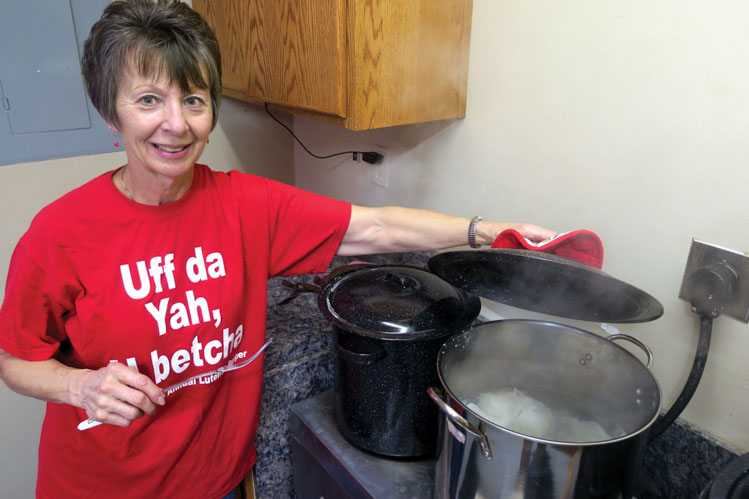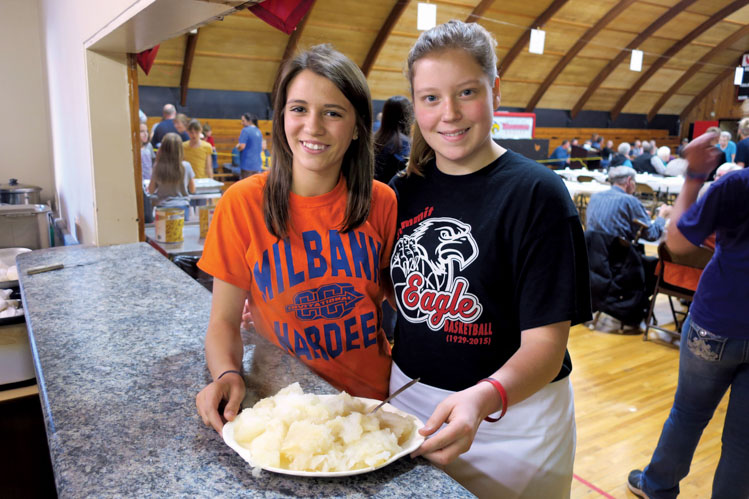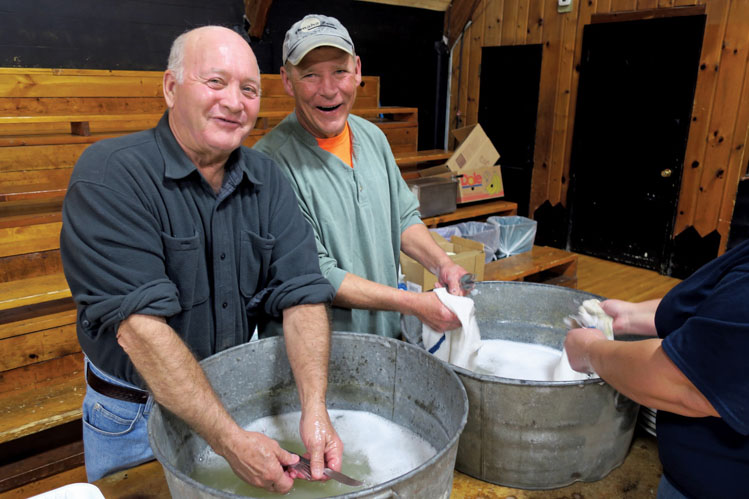The Gift of South Dakota
Subscriptions to South Dakota Magazine make great gifts!
Subscribe today — 1 year (6 issues) is just $29!
Summit's Lutefisk Tradition
 |
| Diners at Summit's annual lutefisk supper got a plateful, but the fish was the star of the evening. |
Editor’s Note: The town of Summit hosted an annual lutefisk supper for around 80 years, but the event ended after the 2019 gathering. This report is from our visit in November of 2016. It appeared in the November/December 2017 issue of South Dakota Magazine. To order a copy or to subscribe, call (800) 456-5117.
***
Here’s a fun recipe for preparing lutefisk. Place a piece of lutefisk on a pine board and flatten it with a cleaver. Sprinkle salt and pepper over the fish and gently ladle melted butter over the top. Bake at a low heat for two hours. Then take the lutefisk out of the oven, throw it away and eat the pine board.
Lutefisk, the fishy centerpiece at the heart of countless memories for South Dakotans who grew up in Norwegian families, has gone from traditional holiday meal to punch line over the years. But it’s no joke in Summit, where every November the entire community helps stage one of the largest and longest-running lutefisk suppers in South Dakota. For $18, diners are treated to all the lutefisk, lefse, mashed potatoes and gravy, corn, ham, coleslaw, cranberries and coffee they can consume.
Lutefisk suppers don’t seem to fill the fall calendar in South Dakota as they once did. Perhaps younger generations aren’t as enamored with the idea of eating fish that’s been preserved in lye. Maybe it’s the distinctly fishy aroma that can emanate from a boiling pot of lutefisk, or the gelatinous texture it can take on when overcooked. Still, the lutefisk suppers that remain often sell out, attracting diners who both truly love the fish and those who are willing to eat it once a year for the sake of nostalgia or to preserve their cultural heritage. We headed into the Glacial Lakes country last year with a camera, notebook and an empty stomach to see how Summit has sustained its lutefisk tradition for nearly eight decades.
 |
| Diane Knutson, of Summit, is among the chefs who have perfected the art of cooking lutefisk. |
The community of about 290 people lies in the far southern edge of Roberts County and just inside the Lake Traverse Reservation, home to the Sisseton Wahpeton Oyate. Its name comes from its location atop the Coteau des Prairies, a rise of rolling hills that sweeps down the eastern third of the state. At 1,968 feet above sea level, it was the highest point between Chicago and Mobridge when the Chicago, St. Paul and Milwaukee Railroad established a station there in 1880.
Because of the elevation, Summit is often susceptible to particularly harsh winter weather. But temperatures were unseasonably warm in the lower 60s when we pulled up in front of the Summit Community Hall. Built in 1952, the gymnasium, with its white block exterior and wood-brown basketball floor and bleachers, looks like something straight out of Hoosiers. In fact, the Summit Eagles (now the Waubay-Summit Mustangs co-op) played basketball there until just last year, when a new $3.5 million addition to the Summit school — including a new gym, music classrooms and community wellness center — was completed.
Advertisements said serving began at 5 p.m., but there were already couples patiently waiting in their cars when we arrived at 3:30. Brenda Redlin, one of the supper’s main organizers, said they often start serving at 4 to accommodate the dozens of people who arrive early and to be sure the lutefisk chefs don’t fall behind. Early arrivals head inside, take a number and patiently wait for their table to be seated.
She expected 550 diners that evening — nearly twice the population of the town — but when she began working at the supper as a high school student in the 1970s, 1,000 guests was the norm. “Back then we couldn’t cook the fish as fast, because we didn’t have the equipment that we do now,” Redlin says. “We had people on both sides of the stands just waiting and waiting. Some people would come buy their tickets and go to the bar. Now we get them through pretty fast.”
 |
| Victoria Zirbel (left) and Cathy Bauer were among the many high school students recruited to deliver plates of fish to the tables. |
Volunteers are clearly at the heart of the annual supper, and it seems that nearly everyone in town has a job to do. Two days before the feed, fourth-graders at the Summit school devote their physical education class time to hauling tables and chairs and setting them up on the gym floor. On Friday night, high school honor society members carefully assemble each place setting.
Redlin has a list of ladies who help prepare 140 dozen lefse, a Norwegian flatbread made from potatoes. The ham and mashed potatoes are prepared at the school and shuttled to the hall because there’s not enough room in the tiny kitchen. Then there’s the cashier, the announcer, the servers, the butter melters, the coffee makers and the dishwashers.
But lutefisk is the star of the show. In 2016, they bought 800 pounds of lutefisk from the Olsen Fish Company. Founded in 1910 in downtown Minneapolis, Olsen’s processes 650,000 pounds of lutefisk annually, making it the largest lutefisk producer in the world. Fish from Olsen’s is used at nearly 500 community suppers throughout the country every year. They also supply novelty napkins and placemats that explain the lutefisk tradition for newcomers.
Pinpointing lutefisk’s beginnings can be troublesome. A popular folk tale says it all began more than 1,000 years ago when Irish citizens, hoping to poison a group of pillaging Vikings, boarded the Norse long ships and poured lye over their fish. But instead of dying, the Norwegians ate heartily and declared the lye-soaked fish a delicacy.
The earliest written reference to lutefisk is in a book by Olaus Magnus, a Swedish writer who worked in the 16th century. Eric Dregni discovered it while working on his book, Vikings in the Attic, about Scandinavian-Americans and the traditions they hold dear. Dregni is a professor at Concordia University in St. Paul, Minnesota, and is also the author of In Cod We Trust, an account of his year spent living in Trondheim, Norway.
Magnus’ book tells the story of an overwhelmingly successful fishing expedition in the North Atlantic. The fishermen brought their bounty of cod to shore, cleaned it on the rocks and cooked and ate as much as they could. When they finished, they simply left the rest behind.
 |
| The boisterous kitchen crew included (from left) Laurie Kneeland, Billi Whempner, Gretchen Wiste, Pan Neugebauer and Stacey Amdahl. |
“Among these rocks were natural basins that filled up with rain,” Dregni says. “Birch ash leftover from their fires combined with water turns to lye, or ‘lute.’ When they came back much later, they found the fish had been perfectly preserved in this lye water. They couldn’t catch anything, so they took this leftover fish down to the sea, washed it off and cooked it. They realized this was a good way to preserve fish.”
Norwegian families used the method for centuries. The process is a bit more refined these days. Cod caught in Norwegian waters is dried before it arrives at Olsen’s in Minneapolis. It’s reconstituted in alternating baths of lye and water for about two weeks.
The lutefisk is delivered to the Summit school and refrigerated in the kitchen’s large coolers. The night before the feed, volunteers bring the fish to the community hall, where they cut it into 2- or 3-inch pieces and soak it overnight in salt water. In the morning, the fish is rinsed and prepared for cooking.
That task falls into the able hands of Diane Knutson and Sheryl Steinocker. They’ve both worked at the annual dinner for over 40 years, and have learned the proper way to prepare lutefisk more by experience than any written recipe. Water boiled steadily in two pots while they explained the process. The fish is placed inside cheesecloth and plunged into boiling water. “They used to say 4 or 5 minutes, but you can’t go by that because some pieces are thicker than others,” Knutson says. “So we stab each bag.”
Lutefisk. Cheesecloth. Boiling water. Five minutes. It sounds simple, but there’s a lot riding on the preparation. “It has to be fork tender,” Steinocker says. “There’s a fine line.”
“And a true lutefisk lover knows where that fine line is, so we have to get it right,” Knutson adds.
When they get it right, they can see it in the empty platters that return to the kitchen almost as quickly as they left. “Sometimes the plate makes it all the way around the table, and other times it only makes it through two people,” Knutson says. “That’s how you tell who the real Norwegians are.”
 |
| Patrick and Maria Quale came from Volga to help their grandmother, Kathy Quale, at the butter-melting table. The siblings are the fourth generation in their family to melt the butter for Summit's annual lutefisk supper. |
Retaining cultural identity is important to those “real Norwegians” as well as South Dakotans from other ethnic backgrounds. It may have played a role in turning this regular Norwegian meal into a community gathering. Dregni points to the World War I era, when immigrant families in the Upper Midwest still spoke their native languages, read native language newspapers and engaged in cultural practices brought over from Europe. When war broke out and patriotic fervor swept the nation, a shadow of suspicion was cast over these families (Germans specifically, but Scandinavians were sometimes included). Dregni believes get-togethers such as lutefisk dinners helped families retain their Norwegian-ness. Summit’s began at the Hope Lutheran Church. It’s now organized by a group called Summit Area Economic Growth, and money raised goes back into the community to support summertime activities for youth.
Despite the sense of togetherness lutefisk helps to foster, at some point it became the strange fish that people like to joke about. Even the internet is getting in on the fun, though perhaps unintentionally. Google the word lutefisk and among the first results is a pronunciation guide that explains the first syllable sounds like “lewd,” as in something dirty, filthy, foul, gross or nasty.
We found the pine board recipe in a book called O Lutefisk by Red Stangland, who grew up in Hetland and worked in radio in Sioux Falls but found his niche in the ethnic joke industry. He founded Norse Press and published millions of joke books featuring the exploits of Norwegian characters like Ole, Lena, Sven and the often-disparaged lutefisk. Here’s the first verse of Oh Lutefisk, Stangland’s parody of the Christmas song Oh Tanenbaum:
Lutefisk … Oh Lutefisk … how fragrant your aroma
Oh Lutefisk … Oh Lutefisk … you put me in a coma
You smell so strong … you look like glue
You taste yust like an overshoe
But Lutefisk … come Saturday
I tink I’ll eat you anyway.
We also learn through Stangland and other Scandinavian humorists like Ed Fischer that lutefisk, when placed around a campsite, is an effective bear repellent. Wrapping your money in lutefisk wards off potential robbers, but lutefisk scented after-shave is a sure way to attract a Norwegian wife.
Did you know that the first person to fly an airplane solo across the Atlantic Ocean was not Charles Lindbergh but a Norwegian pilot from Minnesota? Unfortunately his plane carried a cargo of lutefisk, so no one met him at the airport. You get the idea.
 |
| Rick Knutson (left) and Pete Eccles happily scrubbed dishes in metal washtubs. |
The Summit dinner has not been without its own strange-but-true foibles. One night about 25 years ago the worst-case scenario happened: they ran out of lutefisk. So someone called a grocery store in Milbank, 22 miles east along Highway 12. The clerk put some lutefisk in the back of the county sheriff’s car and the officer sped west with lights flashing to Marvin Hill, a high spot about midway between the two towns, where he met someone from Summit who transported the precious cargo the rest of the way. Crisis was averted thanks to a law enforcement escort that perhaps no South Dakota food other than lutefisk would ever receive.
But we didn’t notice any hiccups. A kitchen full of sous chefs happily prepped hundreds of pounds of lutefisk, despite questions from a magazine writer. (“Do you want a mimosa?” one of them asked us. “Don’t put that in your article!” said another amid gales of laughter.) Kathy Quale and her grandchildren, Patrick and Maria Quale, melted 108 pounds of butter and skimmed the foam off the top of every cup, just the way grandma used to. Lyle and Candace Zirbel kept watch over the egg coffee. Earline Holt, Rick Knutson and Pete Eccles, who also serves as the mayor of Summit, joked as they scrubbed dishes in old washtubs. It seemed there was no place any of them would rather be.
And the plate of lutefisk we enjoyed was perfectly flaky, topped with a shake of pepper and a couple of tablespoons of silky melted butter. We didn’t even miss the pine board.










Comments
Hopefully will be back again this year! And Go Packers not Vikings!😂